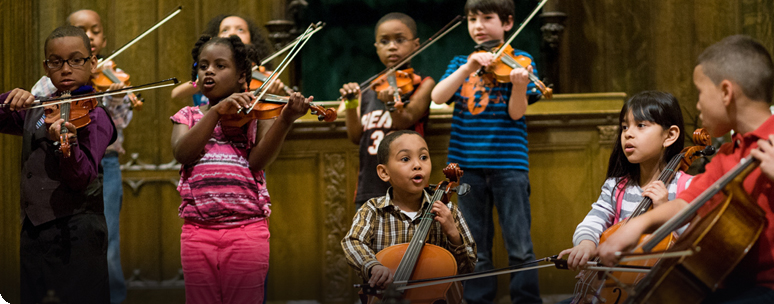St. Lawrence String Quartet tripCMW resident musician Jesse Holstein describes an unconventional and thought-provoking Phase II concert trip to hear the St. Lawrence String Quartet: Last Friday Sebastian and I took a group of Phase II kids down to URI in the big blue bus to hear the St. Lawrence String Quartet. The St. Lawrence is a youngish group in residence at Stanford University. As the lights dimmed and they came out on stage, one could tell from their dress that this was going to be a different kind of concert. Geoff Nuttall, the group’s first violinist was wearing a suit and tie; Barry Shiffman on second fiddle was wearing a black untucked Nehru-collared button up; Chris Constanza the cellist was decked out in a bright blue blazer with a white shirt and no tie; and Lesley Robertson, the violist, rounded out the group in a black sequined halter-top and black slacks. Right away, through their demeanor and wonderfully communicative playing, they shed the fetters of formality and delivered a capricious reading of Haydn’s “Joke” quartet. Good stuff! They even started to stand up at the finale’s false ending before sitting back down to sew the piece up. Our kids and the rest of the audience responded with a good chuckle, which the Quartet appreciated. Following a great introduction by Geoff, the St. Lawrence delivered a searing performance of Osvaldo Golijov’s Yiddishbbuk. As some may recall, the PSQ played this piece in April of 2004, and it requires the performers to create many unconventional sounds with their equipment: banging the stick of the bow on the strings, sliding grotesquely, vibrating like a nanny goat, gossamer harmonics opposed by granitic blocks of sound, to name but a few. It was riveting for our kids to hear and see “classical” music like this. We went backstage at intermission to meet the artists and they welcomed our Phase II kids with warmth, kindness, and by offering up their backstage snacks; the best three ways into anybody’s heart! The Quartet asked the kids what they thought of the Golijov, perhaps expecting an “it was good…” response, since comprehending contemporary music’s varied vocabulary can be difficult for even the most seasoned concertgoer. Jovanne replied with a memorable line, “It was too alive to be classical!” Several other kids seconded Jovanne’s opinion and gave their enthusiastic approval. This response got the St. Lawrence’s attention, as well as Sebastian’s and mine. The Quartet asked our kids what instruments they play and what they are working on, and Fidelia told them about this month’s Phase II project—which she is leading—to collect supplies and money to send to the Gulf Coast to contribute to the Katrina relief effort. Although we could only hang out with them for 10 minutes or so, the kids and the St. Lawrence Quartet were clearly well on their way to becoming fast friends and chamber music colleagues. After hearing the astounding Schumann A Minor Quartet, the audience wanted more. For their encore, they prefaced their Mozart slow movement by mentioning that they had an idea for their next concert to put pillows just in front of the stage for young people to get up close to the band. Well, with a little encouragement from Sebastian and me, our kids came up the aisle and plopped down on the floor just a couple of feet away from the Quartet. It was magical! Afterwards, we went backstage again to thank them and to snap a quick picture [to be posted soon] before getting on the bus to Providence. * * * * Part of the struggle that the classical music industry has been experiencing for the last few years has been brought on by the distance that is created between the audience and the performers during “classical” concerts. Audiences at “classical” concerts are expected to remain still and silent as all-too-often unsmiling performers reverently play old museum pieces with nary a word being uttered to bridge the gap. Added to this, the dress of quartets and orchestras is often completely uniform and the performers are expected to bow and stand together, adding to the automaton-like presentation. Perhaps other ensembles could take a cue from the St. Lawrence and try to bridge the divide between performer and audience aside from just showing up for juice and cookies at the reception? These guys get it and our Phase II kids clearly responded. What a great night! -Jesse Holstein, Providence String Quartet |
